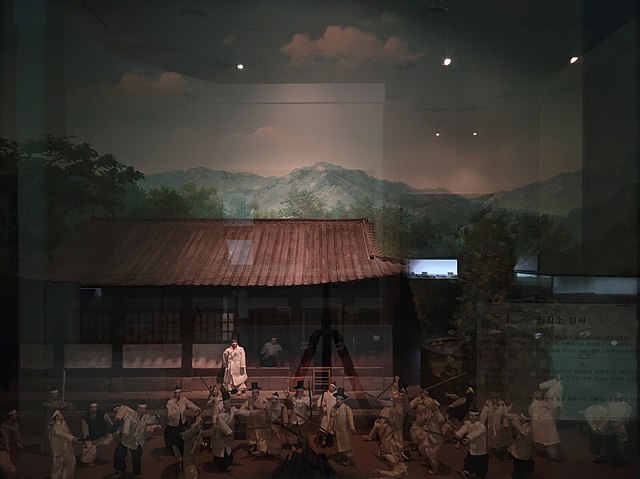The Battle of Ugeumchi took place in the Ugeumchi area, from October 23 to November 11, 1894. It was a conflict between different factions, including the Donghak peasant army, the Capital Guards Command consisting of the Palace Guards (Gyeongricheong), Royal Escort Palace Guards (Jangwiyeong), and the Metropolitan Guards (Tongwiyeong), and the new well-trained Japanese-style Military Training Division (Hullyeondae), which were the elite forces of the Joseon government equipped with modern weapons and tactics. Despite the overwhelming numerical advantage of the peasant army, they were unable to break through the defensive line of the suppressing forces, who had superior weapons and tactics. The defeat in Ugeumchi led to the rapid disintegration of the peasant army and the loss of momentum in the Donghak Peasant Revolution.
Painting of the Battle of Ugeumchi
A gatling gun used during the battle.
Illustration of the Donghak Peasant Army battling the Joseon-Japanese Alliance.
Memorial of the Battle of Ugeumchi.
Donghak Peasant Revolution
The Donghak Peasant Revolution (Korean: 동학농민혁명) was a peasant revolt that took place between 11 January 1894 and 25 December 1895 in Korea. The peasants were primarily followers of Donghak, a Neo-Confucian movement that rejected Western technology and ideals.
Jeon Bong-jun, the leader of the revolution
Sabal Tongmun code, made by twenty rebels of Jeongeub, Gobu, and Taein, including Jeon Bong-jun
The jangtae was initially intended for raising chickens but used to avoid bullets by hiding behind them by filling the inside of the jangtae with rice straw or rolling it down from a high place to block the soldiers coming up to suppress the peasant army.
Establishment of the Local Directorates (Jipgangso)








